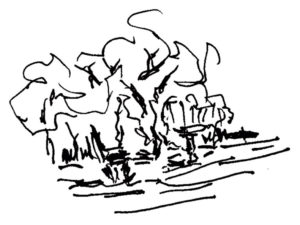Columnists
Knee high

Within arm’s length from where I sit, I study a wasp as it lands on the edge of a birdbath. The wasp is soon joined by a second one; a cicada sings from the prairie grasses beyond. The rust-coloured leaves from the three-storey poplar trees blanket the driveway, autumn-like. Stress has driven the poplars to drop their foliage.
The wasp descends into the partially-filled bird basin, arriving at water’s edge. The second wasp joins in. The concrete structure, heated by the noonday sun and the air above, has soaked up much of the cool well water I had added early this morning. There is drowsiness, a silent surrender, a longing feel to the land in the dry weight of the day.
I have never witnessed this before, where a wasp, head lowered, bobs then drinks like a bird. Crouched to the water, sipping. It was no longer the nuisance wasp, the wasp with the sting, but a tiny living creature depending on that drink to survive.
How does the farmers’ saying go? “Knee high by the 4th of July?” Corn that is. But not this year. In our Great Lakes region with a typical rainfall of 25 to 50 millimetres a month, it may be possible that this summer, we understand more about drought and its consequences: the unsettling feeling that we ourselves feel when something is just not right. Not right that the rains just ain’t a comin’. Living along the largest body of fresh water in the world, it helped me to think about places where drought is a part of everyday life and where appreciation and thanks are offered for every drop of water. I want to remember that.
 It was the fishermen along the west coast of South America who noted that ocean currents and wind shifts were changing and diminishing their harvest; that the nutrient-rich cold water that would normally well up from the depths of the ocean, bringing the fish with it, was not occurring. They noted the phenomena happening every two to seven years and lasting between 12 and 22 months. The effect peaked around the Christmas season and they began to call it “the Christ Child”- El Niño.
It was the fishermen along the west coast of South America who noted that ocean currents and wind shifts were changing and diminishing their harvest; that the nutrient-rich cold water that would normally well up from the depths of the ocean, bringing the fish with it, was not occurring. They noted the phenomena happening every two to seven years and lasting between 12 and 22 months. The effect peaked around the Christmas season and they began to call it “the Christ Child”- El Niño.
Scientists began work on the weather pattern—El Niño—studying tree rings, sediment in ice cores, coral reef samples and historical accounts from early settlers. They have traced its history back hundreds years.
So the County has known drought before. But not in modern times. Soy is more drought resistant, but to witness the barely recognizable corn fields of the region is an eye opener. Will the rains of recent days partially rescue the crop?
It was Native Americans in the Central Balsas River Valley of southern Mexico that domesticated a wild grass called Teosinte, from which they developed maize—corn. From that region, known as the cradle of maize evolution, has come one of most important food crops in the world. Today, 15 million square kilometres of land is covered in cropland; sixteen per cent of it is irrigated. Corn grows on much of that land. Twenty one per cent of human nutrition across the globe comes from corn. Think about corn flour, corn bread; corn syrup in everything from Coke to Froot Loops. Have you had popcorn, tortillas or tacos lately?
On a day like today, iced coffee or homemade lemonade makes it bearable. I watch as the wasps linger in the shade of the sumac that surrounds my veranda. They have had their share of water and are about to carry on with their day. As for me, the heat and its lethargic effect are good cause to just hang right in there, have a longer sit and anticipate the next critter to come my way.

Comments (0)